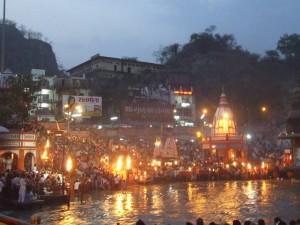SuperbugsSuperbugs presence increases during annual pilgrimage to India’s sacred sites
The spread of antibiotic-resistance to one of the most pristine locations in Asia is linked to the annual human pilgrimages to the region, new research has shown. The researchers have found that in May and June, when hundreds of thousands of visitors travel to Rishikesh and Haridwar to visit sacred sites, levels of resistance genes that lead to “superbugs” were found to be about sixty times greater than other times of the year. They argue that preventing the spread of resistance genes that promote life-threating bacteria could be achieved by improving waste management at key pilgrimage sites.

Pilgrimages swell the population, exposing more to 'superbugs' // Source: madhyamam.com
The spread of antibiotic-resistance to one of the most pristine locations in Asia is linked to the annual human pilgrimages to the region, new research has shown.
Experts from Newcastle University, the United Kingdom, and the Indian Institute of Technology in Delhi (IIT-Delhi), sampled water and sediments at seven sites along the Upper Ganges River, in the foothills of the Himalayas.
A Newcastle University release reports that they found that in May and June, when hundreds of thousands of visitors travel to Rishikesh and Haridwar to visit sacred sites, levels of resistance genes that lead to “superbugs” were found to be about sixty times greater than other times of the year.
Publishing their findings today in the journal Environmental Science and Technology, the team says it is important to protect people visiting and living at these sites while also making sure nothing interferes with these important religious practices.
They argue that preventing the spread of resistance genes that promote life-threating bacteria could be achieved by improving waste management at key pilgrimage sites.
“This isn’t a local problem — it’s a global one,” explains Professor David Graham, an environmental engineer based at Newcastle University who has spent over ten years studying the environmental transmission of antibiotic resistance around the world.
“We studied pilgrimage areas because we suspected such locations would provide new information about resistance transmission via the environment. And it has — temporary visitors from outside the region overload local waste handling systems, which seasonally reduces water quality at the normally pristine sites.
“The specific resistance gene we studied, called blaNDM-1, causes extreme multi-resistance in many bacteria, therefore we must understand how this gene spreads in the environment.
“If we can stem the spread of such antibiotic resistant genes locally — possibly through improved sanitation and waste treatment - we have a better chance of limiting their spread on larger scales, creating global solutions by solving local problems.”
Funded by the Engineering and Physical Sciences Research Council (EPSRC), the aim of the research was to understand how antibiotic resistance was transmitted due to a specific human activity.
Local “hot-spots” of antibiotic resistance exist around the world, particularly densely-populated regions with inconsistent sanitation and poor water quality.
By comparing water quality of the Upper Ganges in February and again in June, the team showed that levels of blaNDM-1 were twenty times higher per capita during the pilgrimage season than at other times.
